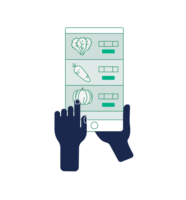How blockchain improves transparency & food safety
Using blockchain technology can drastically improve the transparency of food and beverage origins and stops along the supply chain.

While blockchain technology has been around for more than a decade, its popularity caught fire with the rapid rise of cryptocurrencies. However, the food and beverage industry has been slow to adopt it, particularly in the supply chain.
Every year, one out of every 10 people around the world gets sick, and even worse, hundreds of thousands die. Where blockchain can help is in tracking the source of an outbreak throughout the supply chain—from the farm to the shipper to the carrier and finally reaching either a restaurant or a store’s shelf. Having the ability to track the source of food all the way back to its roots can go a long way for improving food safety.
From a transportation perspective, the disconnect between shippers and carriers occurs far too often. And, while over the years, the gap has closed a bit with new regulations like the Food Safety Modernization Act (FSMA), the disaccord could be lessened even more with blockchain technology.
Currently, shippers and carriers use a multitude of systems to track shipments through the transportation portion of the supply chain. For example, a transportation management system (TMS) provides periodic updates about the trucks’ driving status—i.e. breaking too quickly or changing speeds too fast—or the temperature conditions within the trailer, which is especially important when transporting refrigerated or frozen foods. A telematics on-board computer, which acts like a cell phone for mobile communications, provides near real-time GPS locations.
But, the disconnect is still there. Even when companies have the necessary systems in place, the carriers often don’t share the data that the systems collect with the shippers. This creates a lack of transparency, and valuable information about food origins slip through the crack.
Using blockchain technology can drastically improve the transparency of food and beverage origins and stops along the supply chain. When an item is produced and packaged at the source, it receives a unique identification, whether it be on a by-product basis or a by-crate-of-product basis. The blockchain starts here, and that information is stored in a secure ledger made available for all parties concerned. Another side advantage is that everyone gets the same view of the data, thus preventing data interpretation issues downstream.
Once those products are loaded into a truck for transportation, the ID is scanned again and the ledger is updated once more. The blockchain also captures data from the carriers’ systems to ensure that products weren’t damaged during transport.
Then, once the products reach their destination, the IDs are scanned once more to indicate such. Finally, consumers can scan the products at the store upon checkout or ask the restaurant for more information to receive final details.
The real benefit of blockchain in the food and beverage industry lies in the ability to quickly find the source of a foodborne illness outbreak and isolate it. The ledger securely holds all the information, which prevents from others tampering with it. When a foodborne illness outbreak occurs, investigators can quickly check the ledger to see who handled the food throughout any step of the supply chain.
Once the source of the outbreak is known, investigators can narrow down the products that might be contaminated. This will help stores and restaurants prevent massive product recalls, as they will know exactly which packages are contaminated.
Through the use of smart contracts, the blockchain technology can be further leveraged to auto-alert carriers from delivering the contaminated products in-transit, thus reducing the casualty and operating cost. The same concept can also be applied to extend the shelf life of produce items by auto-routing them to nearby stores if forecasted to arrive late at the destination when unplanned events such as border crossing delays, heavy traffic congestion, truck breakdown or severe weather conditions occur.
Furthermore, blockchain technology can be used to identify the freshness of a product. It is very common in the food industry for retailers to reject shipments if the product does not meet their standards. Storing the freshness information in a blockchain system provides a higher chance for producers to meet retailers’ requirements and minimize waste.
The greatest reason for implementing blockchain technology would be to reduce the number of illnesses and deaths from foodborne illnesses each year. Maybe blockchain is the solution that the food and beverage industry is searching for.
Looking for a reprint of this article?
From high-res PDFs to custom plaques, order your copy today!





